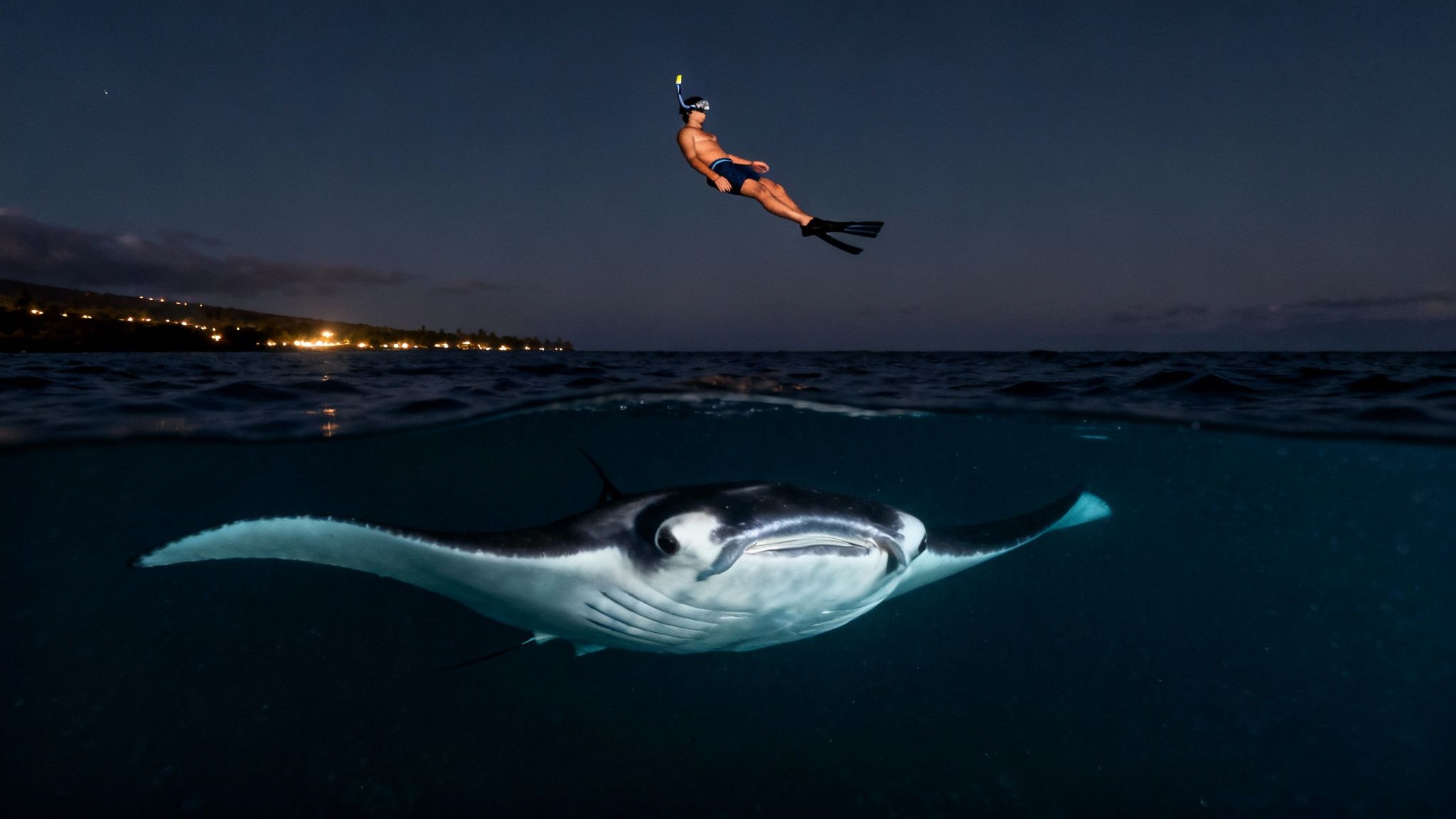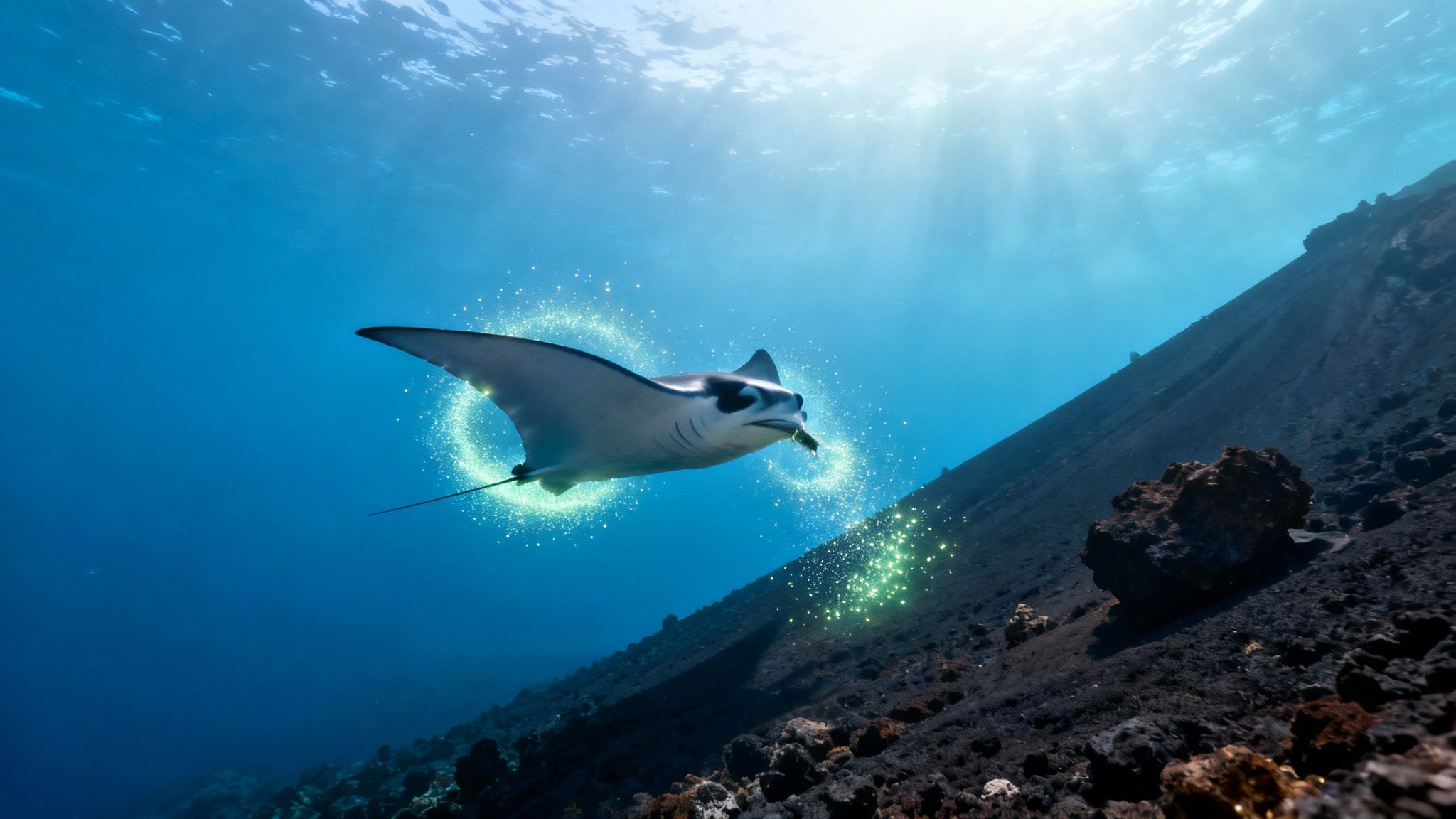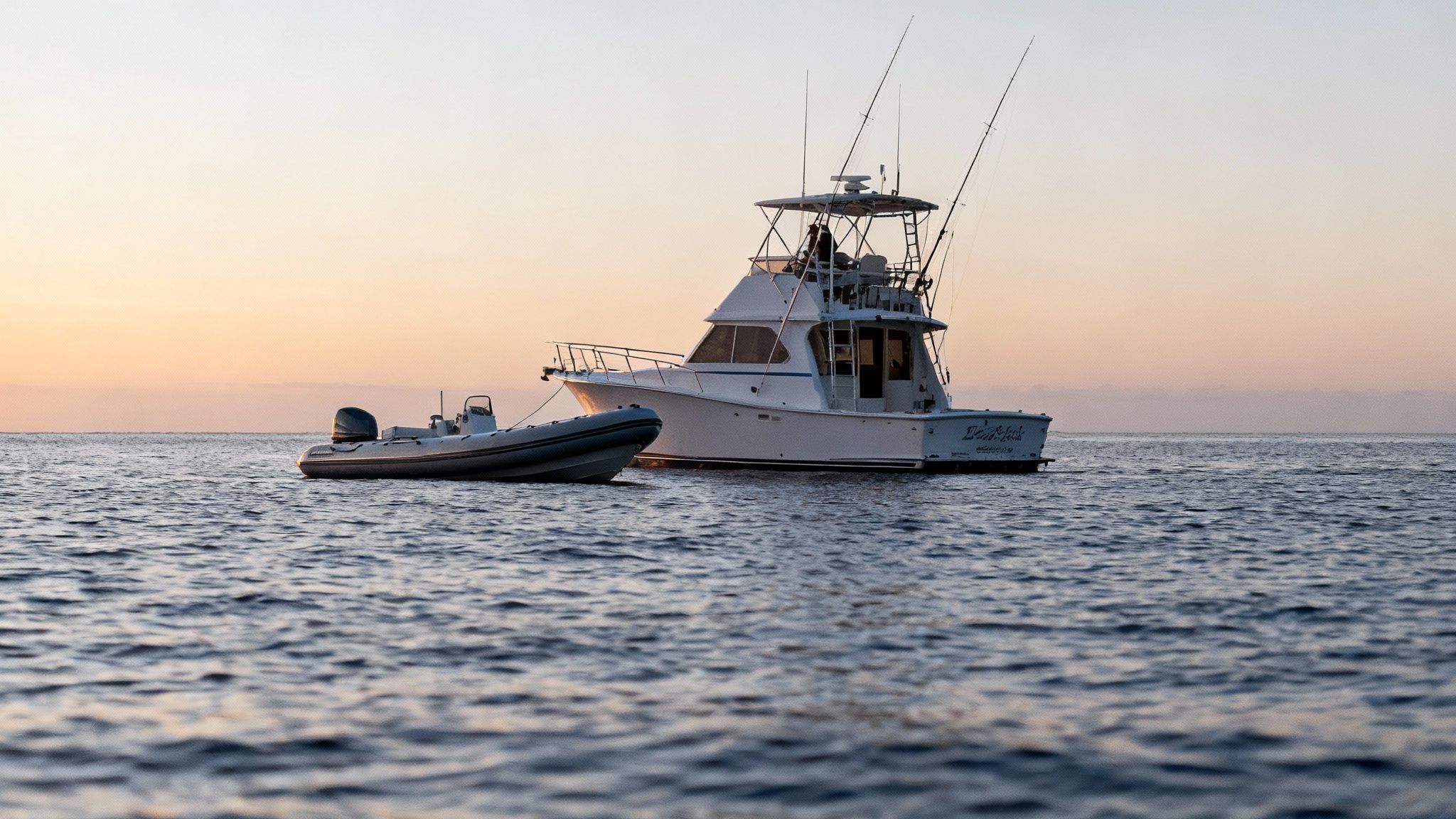Manta Ray Snorkel Big Island Guide
- Byron
- 1 day ago
- 11 min read
Picture this: you're floating in the warm, dark waters of the Pacific off the coast of Kona. Below you, a silent ballet unfolds as enormous, graceful creatures with wingspans reaching up to 14 feet glide and loop just inches from your face. This isn't a dream; it's the world-famous manta ray night snorkel on the Big Island, and it's an experience you'll never forget. This guide is here to help you make it happen.
Your Ultimate Guide to the Manta Ray Snorkel

We’re going to cover everything, from why Kona is the absolute best place for this adventure to picking the right tour and getting ready for the big night. Forget the generic fluff—we're talking real-world tips to make sure your trip is safe, respectful, and completely mind-blowing.
Whether you're a first-timer with a few butterflies in your stomach or a seasoned snorkeler looking for the next big thing, you’ll find solid, actionable advice here. Get ready for an up-close look at Kona's legendary 'manta ray ballet'. You can find more information on our home page.
And for those of you coming from abroad, staying connected is a must. Before you pack your bags for the Big Island, check out this comprehensive guide on eSIM for international travel to sort out your phone situation easily.
Why Kona is the Global Epicenter
There's a reason the Big Island, and specifically the Kona coast, is known as the best place on Earth to see manta rays. It's not just hype; there's hard data to back it up. Between 2009 and 2014, researchers tracked a staggering 80-90% success rate for manta sightings on night snorkel tours.
So, what’s Kona’s secret? It comes down to a perfect storm of volcanic underwater geography and steady ocean currents. This combination creates a rich buffet of plankton—the mantas' favorite food—which draws them to the same spots reliably, night after night. This natural setup creates an underwater spectacle you can count on almost any day of the year.
The whole experience feels surreal, like you're watching a silent, perfectly choreographed performance. The sheer size and grace of the mantas as they perform their feeding acrobatics is something photos and videos just can't do justice.
To get the most out of this adventure, you have to go with a quality tour operator. For an absolutely top-notch experience, we always point people toward Manta Ray Night Snorkel Hawaii. Another fantastic choice, whether you're looking for the manta snorkel or a day trip to Captain Cook, is Kona Snorkel Trips.
Why Kona Is the Global Hotspot for Manta Rays

So, what makes the Kona coast the absolute best place in the world for a manta ray snorkel on the Big Island? It's not a happy accident. It’s a perfect storm of geography and biology that sets the stage for a spectacular natural show night after night.
The island’s unique underwater volcanic slopes and steady ocean currents create an ecosystem teeming with microscopic plankton—the manta rays' favorite meal.
Because of this natural, all-you-can-eat buffet, the local mantas have no reason to leave. They stick around all year, giving us a large, resident population of over 300 identified and named individuals. These smart creatures have even learned to associate certain coastal spots with an easy dinner.
This incredible consistency has made two specific locations world-famous for manta encounters.
Manta Village vs. Manta Heaven
Knowing the difference between Kona's two main manta sites can help you pick the perfect tour, as each offers a slightly different vibe.
Manta Village: This is the original, classic spot, located right off the coast of the Sheraton Kona Resort in Keauhou Bay. It's known for being incredibly reliable, with manta sightings on over 90% of nights. The bay's shape is perfect for trapping plankton, which keeps the mantas coming back.
Manta Heaven: You'll find this site, also called Garden Eel Cove, a bit further north near the Kona airport. While maybe a touch less consistent than Manta Village, when the mantas show up here, they often come in bigger groups. It can be a truly jaw-dropping spectacle.
No matter which spot your tour heads to, the concept is the same. Tour operators have figured out how to work with nature to create an unforgettable encounter. They set up powerful, submerged lights that act like a giant beacon for plankton. The light attracts a dense cloud of plankton, which in turn draws in the hungry mantas for their nightly feast.
This isn't just a random wildlife sighting; it's a learned behavior. The mantas have figured out that the tour boat lights mean an easy meal is served, and they return night after night to perform their graceful, looping feeding dance.
The Science Behind the Show
This nightly event is a fascinating display of marine biology in action. The reef mantas here are huge, with wingspans reaching 12 to 14 feet. As filter feeders, they glide through the water with their cavernous mouths open, scooping up plankton in a series of elegant barrel rolls and swoops.
From your spot on the surface, you'll get a front-row seat to this synchronized "manta ray ballet" happening just inches below you. It's a truly mesmerizing experience. You can learn more about how it all works from the pros at Kona Honu Divers.
Ultimately, it’s this combination of a dedicated, resident manta population and a proven, science-backed method for attracting them that makes Kona the undisputed capital for this adventure. While no one can ever guarantee a wildlife sighting, your odds here are incredibly good.
For more insider tips, check out our guide on the best time to see manta rays in Kona.
How to Choose the Right Manta Ray Tour

Picking the right company for your manta ray snorkel Big Island adventure is a big deal. It's the difference between a good vacation memory and an absolutely unforgettable, once-in-a-lifetime experience. The sheer number of choices can be overwhelming, but it usually boils down to one simple question: what kind of vibe are you looking for?
A lot of that comes down to the boat. Some companies run large, steady catamarans or double-decker boats. These are fantastic for families, especially if you have younger kids or someone in your group who's a bit nervous on the water. They offer a much smoother ride and often come with comforts like on-board restrooms and easy-to-use ladders for getting in and out of the ocean.
Then you have the small, zippy zodiac-style rafts. These boats are all about the thrill. They get you out to the manta site in a flash, giving you maximum time in the water with the rays. If you’re an adventurous spirit or traveling with a small group of friends who don't mind a bit of a bumpy ride, this is your ticket. For a truly top-notch adventure, many people turn to Kona Snorkel Trips, known for their incredible manta ray night snorkel and amazing Captain Cook snorkeling tours.
What Really Matters in a Tour
Beyond the boat, a few key things separate the average tours from the truly great ones. When you're comparing options, keep these factors at the top of your list.
Safety Is Non-Negotiable: A great tour company puts safety above all else. Their guides should be lifeguard-certified, and the crew needs to give everyone a clear, thorough safety briefing before anyone hits the water.
Guides Who Know Their Stuff: The best guides are more than just lifeguards; they're passionate marine naturalists. They'll share fascinating insights about manta ray behavior and biology, turning your snorkel into an educational experience. Their expertise is what keeps both you and the mantas safe.
A Commitment to the Mantas: Look for operators who practice responsible tourism. This means they enforce a strict no-touching policy and use lighting methods that attract plankton without disturbing the rays' natural feeding habits.
To help you visualize the difference, let’s compare the two main boat styles.
Comparing Manta Ray Tour Boat Types
Deciding between a large, stable vessel and a nimble raft can shape your entire evening. This table breaks down the key differences to help you choose the perfect fit for your manta ray snorkel adventure.
Ultimately, your choice depends on who you're with and what kind of night you want to have. A family with a 7-year-old will almost certainly prefer the comfort of a big boat, while a couple of adventurous buddies might love the rush of a zodiac.
Expert Tip: Don't just look at the price. A slightly more expensive tour with a smaller group size, expert guides, and a top-notch safety record is worth every penny for an experience this special.
No matter which boat you choose, going with a reputable company is key. To see our top picks, check out our in-depth guide to the 12 best manta ray snorkel Kona tours for 2025.
Ready to book your spot?
What to Pack for Your Night Snorkel
A little bit of planning can make a huge difference between a good night and an incredible one. Think of this as your pre-flight checklist before you head out for your manta ray snorkel Big Island adventure. We'll cover what to bring, what to leave at home, and how to quiet those common pre-snorkel jitters.
The best trick is to show up ready to go: wear your swimsuit under your clothes. It just makes everything smoother once you're on the boat and ready to hit the water. Toss on something comfy over it that’s easy to slip off.
Essentials for a Comfortable Trip
Once you climb out of the water, the ride back to the harbor can get surprisingly chilly with the night breeze. Having a few key items will make you much happier.
Warm, Dry Clothes: A sweatshirt or a light jacket is non-negotiable. Trust me on this one.
A Towel: You'll be very glad you brought one to dry off.
Reef-Safe Sunscreen: If your tour starts before sunset, make sure to apply it before you leave for the harbor.
Reusable Water Bottle: Always a good idea to stay hydrated, even when you're surrounded by water.
Don't bother lugging your own gear. Any reputable tour operator—like the ones we recommend—will provide everything you need: snorkel, mask, fins, and even a wetsuit.
Pro Tip: A small dry bag is a lifesaver. It keeps your phone, keys, and that warm sweatshirt safe from the inevitable splashes on the boat.
Worried About the Dark or Not a Strong Swimmer?
It's totally normal to feel a little anxious, especially if you've never snorkeled at night before. Let's tackle the two biggest concerns I hear from people so you can show up feeling relaxed and ready for the main event.
First, the fear of being in the ocean after dark. I get it. But the reality is far from a pitch-black experience. The tour boats are equipped with incredibly powerful underwater lights that illuminate a massive area. It creates a brilliant, glowing stage that feels more like a stadium than the open ocean.
Second, what if you're not a confident swimmer? No problem at all. This experience is designed to be accessible for everyone. You'll be given a custom-made flotation board to hold onto. You just float effortlessly on the surface, no real swimming required, giving you a perfect, stable view of the manta ballet below.
For an even more detailed list, check out our guide on the 10 essential items for your manta ray snorkel in Kona.
How to Snorkel Safely and Respectfully with Manta Rays
When you go on a manta ray snorkel, remember you're stepping into their world. You’re a guest in their underwater dining room. Because of this, every tour operator’s top priority is the safety of both the snorkelers and the mantas. It's a shared responsibility that keeps this experience magical and sustainable.
Before you even get in the water, your crew will walk you through a detailed safety briefing. They'll cover a few simple but incredibly important rules. The whole experience is designed around what we call passive observation. This isn't a free-for-all swim. You’ll hold onto a specially designed, floating light board that illuminates the water below, attracting the plankton the mantas come to eat. It’s also your stable flotation device, so you just float comfortably and watch the ballet unfold right beneath you.
The Golden Rule of Manta Interaction
If you take away just one thing from the briefing, make it this: look, but don't touch. This is the absolute number-one rule, and it’s not just a suggestion. It can be incredibly tempting to reach out when a manta glides just inches from your face, but touching them can cause real harm.
Why? Manta rays have a protective mucous coating, a slime layer that's their first line of defense against nasty bacteria and infections. When we touch them, we can rub off that vital layer, leaving them exposed and vulnerable to disease. Simply by keeping your hands to yourself, you're playing an active role in protecting these gentle giants.
Key Guidelines for a Safe Snorkel
Besides the main "no-touching" rule, a few other easy-to-follow guidelines will ensure everything goes smoothly for you, the other snorkelers, and of course, the mantas.
Stay Horizontal: Think like Superman and keep your body flat on the water's surface. This makes you less obtrusive and keeps your fins from dangling down where they might accidentally bump a manta.
No Kicking: Once you’re holding onto the light board, there’s no need to kick. Your wetsuit and the board provide all the flotation you need. Kicking can stir up the water and scare the mantas away.
Listen to Your Guide: These folks are the experts. They know manta behavior inside and out and are trained to keep everyone safe while ensuring the encounter is respectful. Always follow their lead.
Following these simple rules is what keeps the manta ray snorkel a healthy and sustainable attraction. It allows these incredible animals to feed naturally without stress, ensuring they’ll be here to amaze visitors for many years to come.
For a fantastic tour that puts both guest safety and manta well-being first, we always recommend booking with Kona Snorkel Trips. They’re known for their professionalism and expert guides on both their manta ray and Captain Cook snorkeling tours.
What the Manta Ray Experience Is Really Like

Your adventure kicks off as the boat leaves the harbor, just as a classic Kona sunset starts putting on a show. There’s a special kind of excitement in the air, a shared feeling among everyone on board that you’re about to witness something incredible.
Once the boat anchors, the sky darkens from fiery orange to a deep, starry indigo. That's the cue for the crew to switch on the big underwater lights.
Suddenly, the pitch-black water becomes an illuminated stage. You'll see tiny plankton start to gather, drawn to the light like moths to a flame, creating a thick, shimmering cloud in the water. This is the buffet, and the main guests are on their way.
You'll slide into the surprisingly warm water, grab onto a specially designed float board, and peer down into the glowing abyss. And then, you see it—a huge, dark shadow gliding up from the depths.
A Ballet in the Deep
Nothing can truly prepare you for the moment a manta ray, with its massive wingspan, performs a graceful barrel roll just inches beneath your face. Their mouths are wide open, effortlessly filtering the plankton from the water in a silent, hypnotic dance. It’s breathtaking.
While sightings are incredibly reliable, every night brings its own unique magic. For a truly top-notch experience, the manta ray night snorkel offered by Kona Snorkel Trips is one of the best on the island.
Have Questions? We've Got Answers
Thinking about swimming with these gentle giants? It's natural to have a few questions before you dive in. Here are some of the most common things people ask before booking their manta ray snorkel Big Island tour.
Is This Really Safe for Beginners or Kids?
Absolutely! This is one of the most accessible ocean adventures you can have. You're mostly just floating and holding onto a big, bright light board while the mantas do their thing below you.
There’s very little actual swimming involved, and the tour crews provide top-notch flotation gear. It’s a fantastic experience for all skill levels, but it's always smart to double-check with your tour company about any specific age or health requirements they might have.
What’s the Best Time of Year to Go?
This is the best part—anytime! Kona's manta rays stick around all year, so you don't have to worry about a "manta season." These are resident rays, meaning they don't migrate.
Your chances of seeing them are consistently high, often over 90%, no matter when you visit. The best time to go is simply when you're here on the island and ready for an adventure.
Am I Going to Be Cold?
The water in Kona is pretty warm, but you'll be out there for about 45 minutes after the sun goes down. Tour operators provide wetsuits, and they make a huge difference in keeping you comfortable.
My pro tip? Don't forget to bring a warm, dry towel and maybe a sweatshirt or jacket for the boat ride back. Once you get out of the water and the wind hits you, you'll be glad you have it!
Ready to book an unforgettable adventure? Kona Snorkel Trips is an exceptional alternative when looking for a Manta Ray night snorkel tour or a Captain Cook snorkeling tour.
Comments